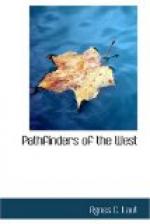[22] It will be noticed that Radisson’s account of the battle at the Long Sault—which I have given in his own words as far as possible—differs in details from the only other accounts written by contemporaries; namely, Marie de l’Incarnation, Dollier de Casson, the Abbe Belmont, and the Jesuits. All these must have written from hearsay, for they were at Quebec and Montreal. Radisson was on the spot a week after the tragedy; so that his account may be supposed to be as accurate as any.
[23] Mr. Benjamin Sulte states that the explorers wintered on Green Bay, 1658-1659, then visited the tribes between Milwaukee and the river Wisconsin in the spring of 1659. Here they learn of the Sioux and the Crees. They push southwest first, where they see the Mississippi between April and July, 1659. Thence they come back to the Sault. Then they winter, 1659-1660, among the Sioux. I have not attempted to give the dates of the itinerary; because it would be a matter of speculation open to contradiction; but if we accept Radisson’s account at all—and that account is corroborated by writers contemporaneous with him—we must then accept his account of where he went, and not the casual guesses of modern writers who have given his journal one hurried reading, and then sat down, without consulting documents contemporaneous with Radisson, to inform the world of where he went. Because this is such a very sore point with two or three western historical societies, I beg to state the reasons why I have set down Radisson’s itinerary as much farther west than has been generally believed, though how far west he went does not efface the main and essential fact that Radisson was the true discoverer of the Great Northwest. For that, let us give him a belated credit and not obscure the feat by disputes. (1) The term “Forked River” referred to the Missouri and Mississippi, not the Wisconsin and Mississippi. (2) No other rivers in that region are to be compared to the Ottawa and St. Lawrence but the Missouri and Mississippi. (3) The Mascoutins, or People of the Fire, among whom Radisson found himself when he descended the Wisconsin from Green Bay, conducted him westward only as far as the tribes allied to them, the Mascoutins of the Missouri or Nebraska. Hence, Radisson going west-north-west to the Sioux—as he says he did—must have skirted much farther west than Wisconsin and Minnesota. (4) His descriptions of the Indians who knew tribes in trade with the Spaniards must refer to the Indians south of the Big Bend of the Missouri. (5) His description of the climate refers to the same region. (6) The Jesuit Relations confirm beyond all doubt that he was among the main body of the great Sioux Confederacy. (7) Both his and the Jesuit reference is to the treeless prairie, which does not apply to the wooded lake regions of eastern Minnesota or northern Wisconsin.




